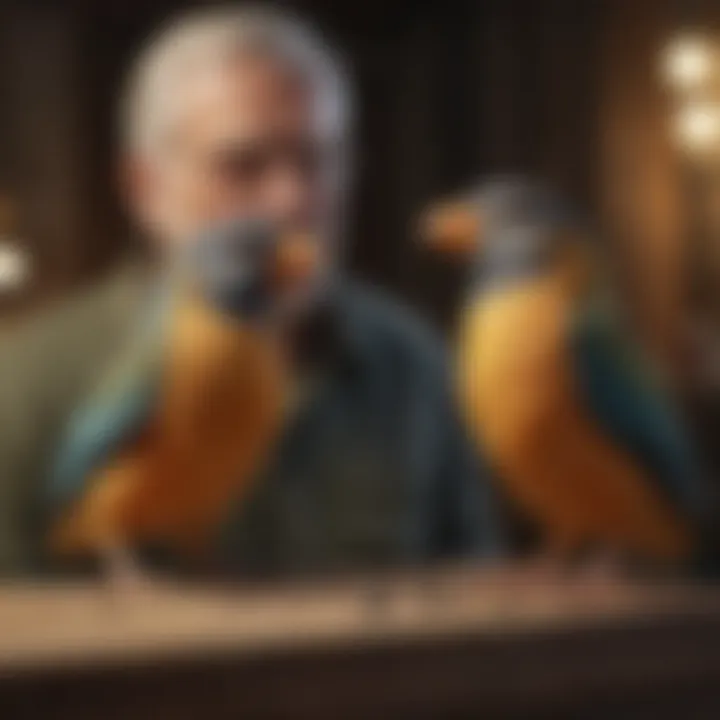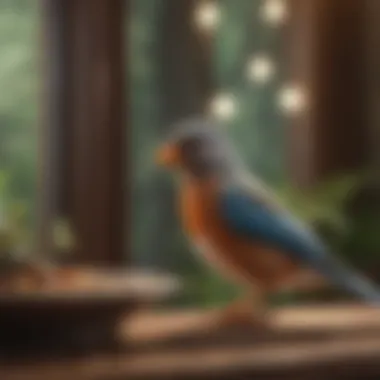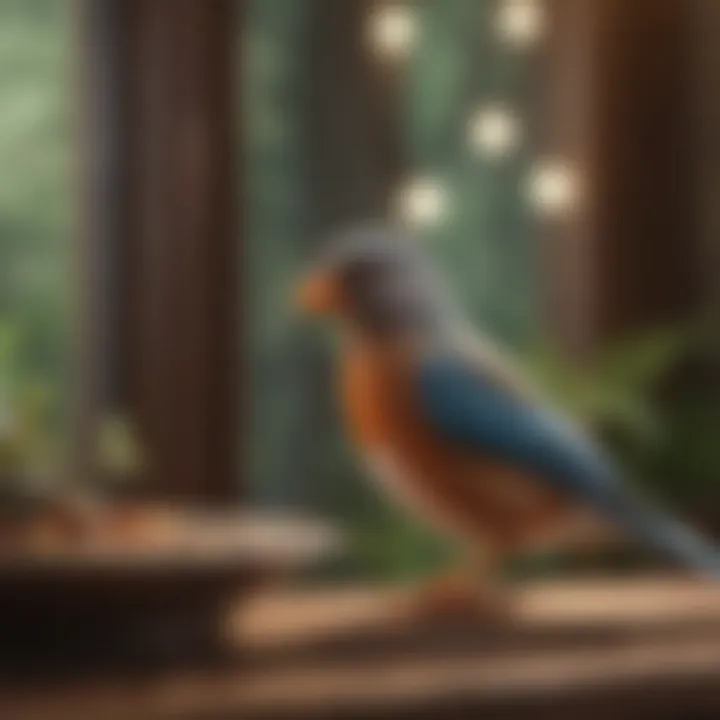Understanding Pet Bird Noise Levels and Behavior


Intro
Pet birds bring a unique cacophony to our homes, filling the air with a symphony of chirps, whistles, and squawks. Understanding the soundscape created by these avian companions goes far beyond merely enjoying their melodies. It requires a detailed exploration of the nuances behind their vocalizations, which are influenced by factors like species, environment, and behaviors. In this article, we aim to demystify the world of bird sounds. We’ll provide insights into how pet owners can interpret and manage these noises effectively, ensuring a harmonious living space for both birds and humans alike.
Care Tips
Taking care of pet birds involves understanding not only their daily needs but also how these needs affect their noise levels. Each species comes with its own vocal habits, making it essential to tailor care to foster a calm environment.
Daily Care Routines
Most bird owners know that consistency is crucial. Having a daily routine helps establish trust and comfort for your feathered friend. Start the day by uncovering the cage at a similar time each morning, allowing the natural light to enter. A consistent feeding schedule also helps in reducing anxiety, which can lead to excessive noise.
Cage Setup and Maintenance
A well-organized cage can significantly impact your bird's behavior. Ensure that the cage is spacious enough for flight and movement. Include perches of varying sizes and textures to stimulate their feet and encourage natural behaviors. Regularly cleaning the cage is not only vital for hygiene but also helps maintain a peaceful environment.
Hygiene and Cleaning Practices
Along with cleanliness, remember that a bird's health is closely linked to their surroundings. Wipe down surfaces and change the lining frequently to avoid odors and promote health. Consider using safer cleaning products, as birds are sensitive to harmful chemicals found in many household cleaners.
Seasonal Care Adjustments
Birds may react to seasonal changes in various ways. Be aware that some birds are more vocal during spring, which is their breeding season. Adjusting your routine and providing additional stimulation can help maintain an ideal sound level during these periods. Ensure that their environment is comfortable, keeping them warm during colder months or providing shaded areas in hotter weather.
Behavioral Insights
Understanding bird vocalizations isn't just about the sounds they make; it's about recognizing the emotions and messages behind those sounds. A bird’s body language often accompanies vocalizations and can tell you a lot about their mood and needs.
Understanding Bird Body Language
Observe how your bird moves as you interact. Fluffed feathers might indicate that your bird is relaxing, while a ruffled appearance often suggests discomfort or irritation. Ears perked, heads tilted, and excited flapping usually come with playful chirps, showing that your bird is happy and engaged.
Common Behavioral Issues and Solutions
Sometimes, excessive noise can stem from behavioral issues. Factors such as lack of stimulation or social interaction may lead to frustration in pet birds. Solutions often include more frequent socialization sessions and providing engaging toys to keep their minds active.
Positive Reinforcement Techniques
Using positive reinforcement when addressing noise can be quite effective. Reward your bird with a treat or attention when they express quieter behavior. This approach reinforces desired behaviors rather than focusing on the negative, making both of your lives more enjoyable.
Social Interaction Needs
Birds are naturally social creatures. If left alone for too long, they might become restless and vocalize more frequently. To maintain a quieter atmosphere, engage with your birds regularly. Mimicking their sounds or introducing playtime can foster a strong bond while reducing noise levels.
Nutrition Guides
Diet heavily influences a bird's behavior, including vocalizations. A well-balanced diet can lead to healthier and often quieter birds, making it paramount for owners to understand the nutritional needs of their specific species.
Essential Diet Components
Incorporate a variety of seeds, fruits, and vegetables into your bird's diet. Pellets specifically formulated for their breed may fulfill many nutritional requirements.
Safe and Toxic Foods
Be well-informed about what foods are safe for your pet bird. For example, most fruits are safe, though an avocado can be dangerous. Create a list of safe foods as a quick reference.
Supplements and Treats
Consider adding dietary supplements, which can promote health and well-being. These may include calcium and vitamin supplements, especially for species prone to certain deficiencies.
Feeding Strategies for Different Species
Every bird species has unique dietary requirements. Some may thrive on a seed-based diet, while others might require more fruits or veggies. It’s essential to research according to the kind of bird you have.
Wellness and Health
Just like humans, birds need regular health evaluations to ensure they are thriving. Keeping an eye on their health can also reduce excessive vocalizations caused by discomfort or illness.
Routine Health Checkups
Schedule regular visits to an avian veterinarian. Preventative health checks can catch issues early and not leave you contemplating whether a noise is a cause for concern.
Identifying Symptoms of Illness
Be on the lookout for changes in behavior that might indicate illness. These could include lethargy, feather plucking, or suddenly increased vocalization.
Preventative Care and Vaccinations
Regular vaccinations and preventative treatments can keep your bird healthy and may reduce stress-induced noise levels. You'll want to stay informed about any recommended schedules for your bird's specific breed.
Mental and Emotional Well-being


Birds require mental stimulation to prevent boredom. This can manifest in excessive noise or destructive behavior. Enrich their environment with toys, varied interaction, and even training exercises to keep their minds active.
Enriching Activities
Engaging your birds in meaningful activities can both enhance their quality of life and help keep their chatter at bay.
Toys and Playtime Ideas
Provide a range of toys that encourage interaction and exploration. Rotate toys regularly to keep their environment fresh. Simple items like cardboard boxes or safe houseplants can provide excellent entertainment.
Training and Tricks
Training your bird is a great way to bond while also reducing noise. Teaching simple commands can provide mental exercise and reduce unwanted vocalizations.
Outdoor Activities and Interaction
When safe to do so, taking your bird outside can provide new sounds and experiences that can satisfy their natural curiosity. Always supervise and ensure their safety to avoid overwhelming them.
DIY Projects for Mental Stimulation
Consider crafting your own toys or puzzles. Simple projects using safe materials can provide birds with engaging challenges, diverting their attention from loud vocalizations.
Engaging with your pet birds isn’t just about meeting their basic needs. It’s also about creating an environment where they feel secure and stimulated, which can lead to a more peaceful home.
By understanding your feathered friends better through these various aspects, from care to social interaction, you begin to grasp the complexity of their soundscape and learn how to manage it effectively. Whether you’re a veteran bird owner or just starting out, this guide aims to equip you with the knowledge to provide a nurturing environment that benefits both you and your avian companions.
Understanding Avian Vocalization
Understanding avian vocalization is pivotal in deciphering the intricate soundscape emitted by pet birds. These vocalizations are not mere noise but rather, a complex language that encompasses emotions, intentions, and social interactions within the bird community. Recognizing these calls can deepen the bond between birds and their owners and foster a harmonious living environment.
Bird vocalizations have different meanings based on their context. For instance, a soft chirp might signal comfort, while loud squawking could indicate distress or frustration. By learning to interpret these sounds, pet bird owners can respond more appropriately to their pets' needs, leading to a healthier relationship.
Moreover, understanding vocalization can aid in anticipating the bird's reactions to certain stimuli. For example, if a bird typically sings during playtime but goes silent upon noticing a looming figure outside, it may be experiencing stress.
Engaging with the topic of avian vocalization enhances one’s ability to manage noise levels effectively in a home setting. This understanding not only benefits the birds but also supports the satisfaction of owners who seek to keep their environments peaceful. Thus, a comprehensive grasp of avian sounds ultimately cultivates a balanced household, blending the natural tendencies of birds with the comfort of human life.
The Nature of Bird Calls
Bird calls are remarkably diverse and can vary widely from species to species. The nuances of these calls often reflect a combination of biological, environmental, and social factors. For instance, the canaries are known for their melodious trills, while African Grey Parrots are famous for their uncanny ability to mimic human speech. This mimicry not only serves their social needs but also showcases their impressive cognitive abilities.
In many cases, calls serve as territory markers or warnings against potential threats. The calls of larger birds, such as cockatoos, can carry over considerable distances, while smaller species often use higher frequencies that may not travel as far but are more effective in dense foliage.
Understanding the nature of these calls requires delving into the evolutionary roles they play. Each species has adapted its vocalization strategy to survive and thrive in its particular ecosystem, highlighting the complex relationship between the birds' soundscapes and their environments.
Communication in the Wild
In the wild, communication between birds largely revolves around survival. Vocalizations serve crucial functions, such as alerting others to predators, establishing territories, or calling mates. Birdsong, for instance, is often a demonstration of fitness, helping in attracting partners during mating seasons.
Social structures within bird flocks can influence these communication methods significantly. Research indicates that some species, like sparrows, showcase a hierarchical communication method, with dominant birds leading the vocal exchanges. In contrast, in flocks of smaller birds, the communication tends to be more egalitarian, with many individuals chiming in while foraging.
Birds also adapt their calls in different environments. For example, open habitats may necessitate louder, more resonant calls, while those living in urban areas may develop altered vocal patterns to cut through the background noise.
Domestic Environment Adaptations
When birds transition from their wild counterparts to domestic settings, their vocalization patterns often change. Adjustments to their new environment can lead to different noise levels and types of calls. Owners may find that their pet birds develop new forms of communication, adapting to the family dynamics and routines.
For example, a budgerigar may become more vocal, mimicking household sounds, such as doorbells or phones, as a way to engage with its human family. On the flip side, stressors in an enclosed space, like new pets or changes in routine, can lead to increased noise levels as birds call out to establish comfort or alertness.
Additionally, domestic adaptations also involve learning from human interactions. Birds are astute observers and can pick up emotional cues from their owners. If they sense tension, they might vocalize differently. Understanding these adaptations provides essential insights for bird owners as they navigate the challenges of managing noise in their homes.
"Bird sounds are not only a window into their world but also a reflection of their lives, adapting to the nuances of human environments in ways that tell us much about their needs and emotions."
By exploring these aspects of avian vocalization, pet owners can cultivate a more profound awareness of their feathered friends, leading to better communication and understanding.
Species-Specific Noise Levels
Understanding the unique noise levels produced by different pet bird species is critical for current and potential bird owners. Every species has its own vocalizations, which can vary widely in frequency, intensity, and purpose. Grasping these differences can help in managing expectations and creating suitable living conditions for both the birds and their humans. Additionally, comprehending species-specific noise levels aids in nurturing a balanced atmosphere where the needs of the birds align well with the comfort of their owners.
Popular Pet Bird Species
Budgerigars
Budgerigars, or "budgies" as they are affectionately termed, are often heralded as delightful companions. Known for their cheerful chirping, these small parrots exhibit vocal behaviors that range from soft tweets to shrill calls. Their sociable nature and tendency to mimic sounds make them an engaging choice for homes. A notable characteristic of budgies is their penchant for chatter, which can sometimes be mistaken for a cacophony of noise. This can be charming, but also overwhelming, depending on one's sensitivity to sound.
Advantages of owning a budgerigar include their lower volume compared to larger species and their ability to bond closely with owners, contributing positively to the household dynamics. However, their need for social interaction means that when left alone, budgies may call out more frequently, suggesting that prospective owners should consider their ability to provide adequate companionship to these lively birds.
Cockatiels
Cockatiels bring a unique charm to any home with their distinctive whistling and soft calling tones. These birds often have individual songs and can even learn to whistle tunes, adding an element of music to the household. The key feature of cockatiels is their relatively gentle vocalizations, making them suitable for quieter living spaces.
What sets cockatiels apart is their expressive nature; they can convey a range of emotions through different sounds. While they are less boisterous than larger parrots, they are still capable of producing loud squawks if startled or feeling neglected. One advantage is their friendliness, which often translates to a light noise level with appropriate social engagement. Nevertheless, owners should be aware that lack of interaction might lead to an increase in vocalization as the cockatiel seeks attention.


Amazon Parrots
Amazon parrots are recognized not just for their vivid plumage but also for their strong, often loud vocalizations. Their natural calls can fill a room, and they are known for being quite vocal, particularly when content or when they want to express frustration. The lively energy that these birds bring can be both a joy and a challenge in terms of noise levels.
The key characteristic of Amazon parrots is their intelligence and capacity for mimicry. They can learn an impressive range of sounds and phrases, enabling them to engage with their owners meaningfully. While this vocal ability can enhance the human-bird bond, it can also mean that the household is subject to variable noise levels, ranging from delightful chatter to boisterous calls. The advantage lies in their engaging personalities, but potential owners should prepare for their louder and more persistent vocalizations, particularly if the bird feels ignored or unengaged.
Comparative Noise Analysis
Small Birds vs. Large Birds
When it comes to noise, the comparison between small and large birds is eye-opening. Small birds, like budgerigars and canaries, tend to produce more gentle sounds, often characterized by light chirps and soft trills. On the other hand, larger birds, particularly parrots like Amazons, can make substantial noise, including loud squawks and vocalizations that can reach startling decibel levels.
This differentiation is crucial for potential bird owners, as it directly influences the choice of species based on living conditions. For example, those residing in apartments or closer quarters might find that small birds offer a harmonious solution, while large birds might be more suited for homes where sound can be better accommodated. However, larger birds can also display quieter periods, especially when well-socialized.
Parrots vs. Canaries
The contrast between parrots and canaries is particularly illuminating. While canaries are celebrated for their melodious singing, they typically maintain a lower volume in comparison to parrots, whose vocalizations can range from endearing chatter to loud calls. Parrots, like Amazons and cockatoos, often develop extensive vocal repertoires that can vary significantly, reflecting their moods and environment.
Choosing between these groups depends on the desired type of sound experience in the home. Canaries might suit those who appreciate natural bird song without overwhelming noise. In contrast, parrots offer a lively, interactive soundscape, engaging their owners with their vocal abilities but requiring attention to manage noise levels effectively. Both groups have their unique features and potential drawbacks, requiring careful consideration from future bird owners.
Factors Influencing Noise Levels
Understanding the factors that influence noise levels in pet birds is crucial for any bird owner aiming for harmony in their home. Various elements contribute to the soundscape these birds create, and every factor interacts with the behavioral and emotional states of the pet. Recognizing these influences can provide vital insights into their actions and the sounds they produce.
Emotional States
The emotional well-being of pet birds plays a big role in how much noise they generate. When birds feel content, they are more likely to chirp cheerfully and exhibit playful sounds. On the other hand, if they are stressed, the noise tends to escalate, often manifesting in louder calls or distress sounds. Understanding these emotional cues makes it possible to tailor the environment to suit their needs, ultimately fostering a peaceful coexistence.
Joy and Playfulness
Birds that experience joy often engage in vocalizations that are light, cheerful, and truly delightful. These sounds can be a sign that they are comfortable and secure in their surroundings. The characteristic of joy in vocalization can be recognized by a more melodic tone and varied pitches.
Some bird species, like budgerigars, sing with a kind of exuberance that reflects their playful nature. The lively sounds produced during playtime create a vibrant atmosphere, positively impacting the owner's mood, too.
However, it’s crucial to note that an excessively noisy bird could also lead to local disturbances, especially in apartments or close-knit communities.
Stress and Anxiety
When it comes to stress and anxiety, the noise levels of pet birds can increase dramatically. Elevated anxiety may cause birds to vocalize repetitively or issue high-pitched calls. This is primarily a means of expressing discomfort or fear. Birds are sensitive creatures; thus, they can react strongly to changes in their routine or environment.
Loud calls can be alarming and might even attract unwanted attention from neighbors. Thus, understanding and addressing the causes of stress is necessary to mitigate such noise levels. Providing safe spaces and consistent routines can help alleviate these stresses, reducing overall noise in the household.
Social Interactions
Birds are social creatures by nature, and their interactions with both owners and other birds have a direct impact on their noise levels. Establishing sound communication is vital for their bonding and social structure.
Bonding with Owners
Birds that share a solid bond with their owners tend to communicate more during play and training sessions, resulting in a fascinating sound dynamic. The laughter and chatter often heard when an owner is involved enhances the bird's contentment, leading to varied sounds ranging from soft coos to enthusiastic whistles. This characteristic indicates a healthy relationship.
Still, it is important to be mindful of the volume. Owners should strive for a balanced interaction where they engage the bird without overwhelming themselves or others in their living space.
Interactions with Other Birds
On the flip side, interactions among birds can produce a cacophony of sounds. Birds often communicate through a wide array of calls with one another. These vocalizations could be alerts or simple chats among friends. For example, when two cockatiels are together, their chatter can range from sweet whistles to loud squawks. This lively interaction is an essential aspect of their social structure.
However, the competing vocalizations can also create a noisy environment, making it pivotal for owners to monitor how their birds interact. Ensuring proper socialization while controlling their noise is a crucial aspect of responsible bird ownership.
Environmental Triggers
The environment that pet birds inhabit significantly affects their noise production. Various stimuli can incite changes in behavior and corresponding noise levels.
Changes in Routine
Birds thrive on routine, and any major disruption can lead to increased noise. When their usual schedule is altered, they may vocalize more, trying to express their confusion or discomfort. For instance, if feeding times shift or their cage location changes, a bird may become vocal in response to these changes.
Using a reliable schedule can help create a stable atmosphere, reducing anxiety and subsequently lowering noise levels. With some patience, birds can adjust to routines without becoming overly vocal.
Presence of Predators
The mere presence of perceived threats can lead to a significant uptick in noise. Birds are instinctively aware of their surroundings and will squawk loudly to alert themselves and socialize in response to perceived danger.
This heightened state of alert often leads to cacophonous displays of distress or warnings, enhancing stress levels not only in birds but also in their human companions. Being aware of the surroundings and mitigating threats can help minimize these anxious sounds, contributing to a more serene environment.
"Understanding the factors influencing a pet bird's noise levels is key to fostering a harmonious living situation. Knowledge empowers owners to manage sounds effectively."
In summary, factors such as emotional states, social interactions, and environmental triggers all play integral roles in determining how much noise a pet bird may produce. Delving into these aspects can provide invaluable insights for anyone looking to better understand their feathered companions.
Managing Noise in Domestic Settings
Creating a homely environment for pet birds is crucial not just for their well-being but also for maintaining peace within a household. Birds, with their communicative nature, add vibrancy to our lives; however, the noise they make can also lead to stress for both the birds and their owners. Understanding how to manage noise effectively can make a significant difference in the quality of life enjoyed by both parties.


Creating a Calm Environment
The foundation of managing noise levels begins with fostering a calm environment. Birds are sensitive creatures, and their vocalizations can often be a reaction to their surroundings. Here are some tips to create that serene atmosphere:
- Consistent Routine: Establish a daily routine that aligns with your bird’s natural behaviors. Feeding, playtime, and quiet periods should happen at similar times each day to promote a sense of security.
- Quiet Zones: Designate specific areas in the home where birds can retreat. These spaces could be away from the hustle and bustle, acting as a sanctuary when things get too loud.
- Calm Sounds: Play soft music or nature sounds. Studies suggest that birds may feel more relaxed with gentle background noise, which can help mask sudden loud sounds.
These small changes can make a world of difference. Birds often pick up on their owners’ stress levels, so keeping a composed demeanor also contributes to a tranquil space.
Positive Reinforcement Techniques
Training pet birds through positive reinforcement methods can drastically reduce unwanted noise. Instead of perceiving vocalizations solely as disruptions, they can be viewed as opportunities for interaction and growth. Here’s how this works:
- Reward Quiet Moments: Whenever your pet remains quiet during a potential triggering moment, reward them with treats or praise. This can communicate that silence is appreciated and valued.
- Redirect Noisy Behavior: If your bird begins to squawk, gently redirect their attention. Offer toys or initiate a game that engages them, while remaining patient.
- Short Training Sessions: Birds, like humans, can become bored. Keeping training sessions short and engaging fosters cooperation while keeping their vocalizations in check.
Utilizing Enrichment Activities
Birds are intelligent beings. Engaging them in enrichment activities can divert their focus and lessen their inclination to vocalize out of boredom. Here’s a list of ideas:
- Puzzle Toys: These stimulate their minds and encourage problem-solving. A well-engaged bird is less likely to squawk unnecessarily.
- Social Play: Arrange playdates with other birds. For social species like cockatiels, interacting with their buddies can reduce loneliness and the resultant noise.
- Physical Activities: Encourage flying or climbing by providing safe spaces. Allowing birds to exercise can channel excess energy, often translating to quieter behavior later.
By integrating these techniques into daily life, pet owners can significantly lessen noise disturbances while nurturing the unique personality of their feathered companions. Finding that equilibrium between nature and nurture is key.
"Creating a positive atmosphere not only improves quality of life for birds but also enhances human-bird interactions."
The Impact of Noise on Human-Bird Relationships
Understanding the intricate web of relationships between humans and their avian companions hinges significantly on the dynamics of sound. For many bird owners, the sounds their pets emit can evoke a range of responses, from delight to frustration. This section aims to dissect the impact of noise on human-bird relationships, examining how sound shapes interactions and overall harmony within a shared living space.
Understanding Human Sensitivity to Sound
Humans possess a heightened sensitivity to sound, which varies across different individuals and situations. A familiar chirp or whistle from a cherished cockatiel may induce feelings of joy and connection, while incessant squawking might lead to irritation or stress, complicating the bond between bird and owner.
Bird species with louder and more varied vocalizations often require more understanding and patience from their human companions. This might mean acknowledging when a pet bird is simply expressing its natural instincts or seeking attention. Owners must recognize their own reaction to these sounds can vary based on context—consider the difference between a joyful morning song versus a distressed call in the evening.
"The sounds of our birds can be a window into their world, reflecting their emotions and environment.”
To foster a more rewarding relationship, it’s essential for pet owners to become adept at interpreting the nuances in their birds' vocalizations and distinguishing between varying noise levels that signify different emotional states.
Finding a Balance
Striking a balance between appreciating avian sounds and managing noise levels is crucial for a peaceful coexistence. One approach involves setting consistent routines to help birds feel secure, which in turn can minimize anxiety-driven vocalization. For example, serving meals at the same time each day can instill a sense of predictability for a pet bird.
Moreover, integrating quiet time into daily schedules allows both humans and birds periods of tranquility, giving each party a break from the constant noise level. Bird owners might also consider using soundproofing techniques or selecting quieter spaces in the home to foster a more harmonious environment.
Here's a list of strategies for finding a balance:
- Establish Routine: Predictable schedules for feeding and social interactions.
- Designate Quiet Hours: Regular intervals for silence to promote well-being.
- Positive Reinforcement: Rewarding moments of quiet with treats or affection.
Long-Term Strategies for Coexistence
Developing a long-term strategy for coexistence involves a commitment from both the bird owner and the bird. Educational resources can offer insights into species-specific behaviors, aiding owners in understanding the when and why behind various sounds. Enrichment activities, such as providing toys and interaction with other birds, can also help mitigate excessive noise as they channel the energy into more productive outlets.
- Engagement: Regularly interact with the pet bird through play, helping to reduce boredom.
- Music and Background Sounds: Use calming music or ambient sounds to mask abrupt noises that might trigger anxiety.
- Training Sessions: Focus on training that encourages quieter behaviors through rewards.
Through these measures, the relationship between humans and their feathered friends can grow stronger, fostering an environment of shared respect and understanding. Interpreting the soundscape of pet birds not only enlightens owners about their companions but also enhances the bond that makes sharing a home so fulfilling.
The End: The Duality of Bird Sounds
The soundscape created by pet birds embodies a melodious mixture that can evoke both joy and perturbation in equal measure. This section encapsulates the significance of understanding this duality in the context of the previous discussions held throughout the article. Recognizing these diversities allows pet owners to appreciate the beauty of avian sounds while managing potential stressors associated with noise levels.
Bird vocalizations are not merely background noise; they are a profound form of communication that offers glimpses into the bird's emotional state and well-being. Being attentive to these vocalizations can strengthen the bond between birds and their owners. As one navigates the domestic soundscape, it becomes essential to balance excitement for their pets' chatter with the need for tranquility in the living environment.
A comprehensive grasp of the nuances in sound allows bird enthusiasts to descry patterns that indicate when their feathery companions are feeling joyous, agitated, or even fearful. Engaging with these vocal cues not only nurtures a deeper connection but also facilitates proactive measures in mitigating stressors—a win-win for both the bird and its person.
Embracing the Sounds of Life
Embracing the natural cacophony that comes with having a pet bird is fundamental to fostering a joyful atmosphere. When one allows the sounds of their feathered friend to permeate their living space, it transforms the household into a vibrant ecosystem filled with personality and life. Just as a melody defines a song, bird calls shape the atmosphere of home.
Consider the distinctive chirps of a cockatiel or the soft trills of a budgerigar. These vocalizations infuse warmth into everyday life. Owners must realize that these sounds often articulate diverse feelings—happiness, curiosity, or even a call for attention.
Encouraging these sounds requires a delicate touch. Here are some strategies:
- Provide social interaction: Engage in regular playtime or simply talk back to your birds, fostering a lively dialogue.
- Choose harmonious environments: Create spaces where the sound is welcomed, avoiding overly noisy areas that might lead to agitation.
- Prioritize enriched environments: Seen from the perspective of a bird, a fulfilled existence encourages varied vocal expressions.
These methods not only enhance the soundscape but also nurture the birds’ health and comfort levels, ultimately leading to a more harmonious living situation.
Building a Harmonious Environment
Crafting a balanced auditory environment for your pet birds is crucial in maintaining peace within your home. Understanding the intricacies of noise contributes significantly to minimizing disruptive sounds that can lead to stress or anxiety for both birds and humans alike.
Effective measures for creating a tranquil setting include:
- Designate quiet zones: Establish areas where noise can be kept at a minimum, ensuring both the birds and their owners have spaces to retreat when needed.
- Moderate interaction levels: While engagement is vital, being mindful of how often and in what manner you interact with your birds can prevent overstimulation.
- Incorporate sound softeners: Utilizing curtains or soft furnishings can dampen sudden bursts of sound, which might startle sensitive feathered friends.
"Creating a noise-friendly habitat is more than just about sound management; it enriches the overall health and happiness of our birds."
By carefully considering these aspects, owners can cultivate a harmonious setting, allowing pet birds to thrive energetically while also enjoying a peaceful existence. This balance fosters a greater understanding of their behaviors and encourages more meaningful interactions, ensuring a long-lasting companionship with our avian allies.















